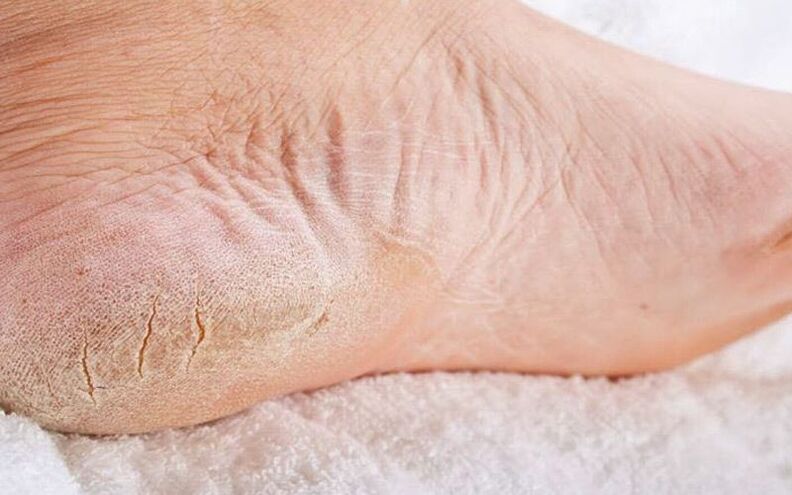
Fungal infections often affect the toes or nails. This disease affects adults and children. To avoid the condition becoming chronic, you need to know the signs of athlete's foot and what it looks like.
Main signs of the disease
Among all skin diseases, athlete's foot is the most common. You can get infected if you ignore basic hygiene rules. Sometimes it is difficult to cure fungal diseases.
For each person, foot fungus begins and develops in its own way. Here are the most common signs of foot fungus:
- Characteristic cracks appear between the toes;
- You can recognize that the fungus has appeared by the characteristic itching symptoms on the feet and between the toes;
- Foot skin is very dry, often peels and becomes rough;
- blisters appear between the fingers, bursting when destroyed;
- Infection can spread to neighboring areas;
- Red spots appear on the skin, causing significant discomfort;
- You can also recognize foot fungus by its unpleasant odor.
When the first symptoms of the disease appear, you should immediately consult a dermatologist. If you don't do this first, treating the fungus will be much more difficult.
Signs of fungus depend on the type of pathogen
This disease develops due to different types of pathogens. Symptoms of foot damage will vary in each case.
- If yeast develops on the feet, the nails gradually become thinner and peel off the bed. The skin on the feet is hyperemic (red in color).
- With the growth of epidermal cells, the nail turns yellow and becomes covered with spots. The skin on the feet peels and gives off an unpleasant odor. A characteristic symptom of this fungus is increased dryness of the skin.
- When mold appears, the nail plate can suddenly change color. The skin turns red if the pathogen gradually spreads to the entire foot. A person experiences itching and the skin may crack. In this case, pain and other unpleasant sensations appear when walking.
Only a doctor can determine the type of pathogen. This cannot be done at home. And if you self-medicate, you can only harm yourself. Your feet will suffer from this, the fungus will spread more and more.

Signs of certain forms of fungus
Depending on the affected area and degree of development, several forms of pathology are distinguished. The symptoms of each are different. Knowing the initial signs of foot disease, you can begin treating mycosis in time.
- Interdigital dermatosis is the most common stage of the disease. It becomes more active in spring and summer, when feet sweat the most. Cracks and ulcers appear between the fingers. You may notice the presence of scales on their skin. The feet look completely healthy. Often a person feels itchy.
- The erased form appears at the least obvious level. Peeling is noticeable between the fingers. At this stage of the disease, a strong unpleasant odor spreads from the feet: it appears due to increased bacterial activity.
The disease can occur in many different forms. Let's get acquainted with their signs so that we know how to identify fungus on the feet and, if it develops, begin treatment. It must be remembered that in severe stages of the disease, the nail is completely destroyed. It is almost impossible to restore it.
Scale type
This type of fungus is characterized by strong peeling of the epidermis. Furthermore, the skin between the toes and the sides of the feet is most severely affected. There are no signs of an inflammatory process. In the photo of the first signs of foot fungus, hyperemic areas can be noticed. Scale mushrooms look like this:
- stratum corneum thickens;
- the skin is shiny, sometimes becomes thick;
- Patterns on the skin become clearer;
- The fungus gradually spreads to the fingers, the entire foot and affects the nails;
- Sometimes scales appear on the epidermis;
- The patient did not feel any other discomfort.
Dyshidrotic type
With this type of fungus, small blisters filled with fluid appear on the skin. They are usually found on the side of the foot. They then gradually move to the inside of the finger. How to identify dyshidrotic foot fungus:
- Bubbles are usually single, but if there are many bubbles, they will merge into one large bubble;
- If left untreated, the fluid in the blisters will gradually darken;
- If the blister bursts, erosion accompanied by a crust will appear in its place.
With this type of foot fungus, there is a very high risk of infection. The infection enters the body through open skin lesions.
alternating type
This type of mushroom is the most common. At first, the patient does not feel any symptoms. Up to a certain point, the skin on the toes does not change. Then cracks and layers appear. The skin is not affected but may sweat.
Candidiasis of the feet
Characteristic symptoms of this fungal infection are as follows:
- damage to the 3rd or 4th toe;
- red and swollen skin;
- There are bubbles around the wound, where the skin is peeling off;
- There are pustules and blisters nearby.
If a bacterial infection enters the affected area, it will lead to a local increase in temperature. Swelling is clearly visible on the skin of the legs. In severe cases, a person experiences general hyperthermia.
Signs of fungal nail infection
A person's toenails may also be affected. The disease can be distinguished by the following symptoms.
- Visible change in the color of the nail plate. Depending on the type of disease the patient has, the nails will have many different shades. Sometimes it can change only on part of the nail plate.
- Nails crumble. It only happens at advanced stages. If the nail becomes completely infected, it will be destroyed.
- Change the structure of the nails.

There are several types of onychomycosis, a fungal infection of the nails.
- Atrophy appears. The nail plate looks very thin. It is darker, sometimes grayish brown. Nails gradually peel off the bed. The skin underneath becomes keratinized and becomes loose.
- With the normal form of foot fungus, the plate changes color. Spots appear on it - white, yellow, green and even black. The structure of the nail is not affected.
- In the hypertrophic form, the sheet gradually thickens and becomes spongy. The affected area is unsightly and in some cases causes pain when walking. On the sides it crumbles and collapses without treatment.
Some types of nail fungus
Depending on the degree of spread of the disease, its forms are distinguished.
- Lateral onychomycosis is the most common. A small yellow spot first appears at the free edge of the nail. In the future, you will notice how it increases and the nail plate thickens. When walking, a person feels discomfort. The spread of an unpleasant odor is noticeable. Lateral onychomycosis is difficult to treat.
- Superficial onychomycosis is characterized by damage only to the upper layers of the plate. It doesn't thicken but over time it becomes chalk-like.
- The rarest form of the disease is sublingual onychomycosis. The skin is noticeably thickened in the nail folds. Nails turn white and lose transparency.
General principles of treatment
Any medical treatment begins with diagnosis. Only then can appropriate remedial measures be taken. Self-medication often leads to worsening of the foot condition. Let's get acquainted with the most popular treatment methods.
- At the first signs of fungal infection, special varnishes, plasters, ointments and sprays are used. They must be used over long periods of time and as directed.
- If local treatment is ineffective, complex antifungal drugs will be prescribed. They are taken orally.
- Surgical removal of the affected nail.
- Laser therapy.
- In advanced forms of the disease, systemic medications are prescribed.
You can avoid the occurrence of an unpleasant disease by observing hygiene rules. You should avoid using other people's personal hygiene products (towels, slippers). When the first signs of the disease appear, you should immediately consult a doctor.
Types of fungal diseases
Fungal foot infections often appear between the toes. It is caused by certain types of fungi. This problem is most often inherent in adults, since children's sweat can neutralize the fungus.
Fungal lesions can be of different types:
- candida - occurs when the body's resistance decreases, most often in women;
- Epidermolysis bullosa is a male-specific disease that develops due to excessive sweating;
- Rubromycosis is a highly contagious form that can occur even in young children.
Signs and forms of the disease
Signs of fungal infection may vary depending on the patient's age, the state of the immune system and the nature of blood circulation.
In people with strong immune systems, fungi can exist on the skin for several months without showing any symptoms. Mild itching and mild redness of the skin may occur.
Best treatment and remedies
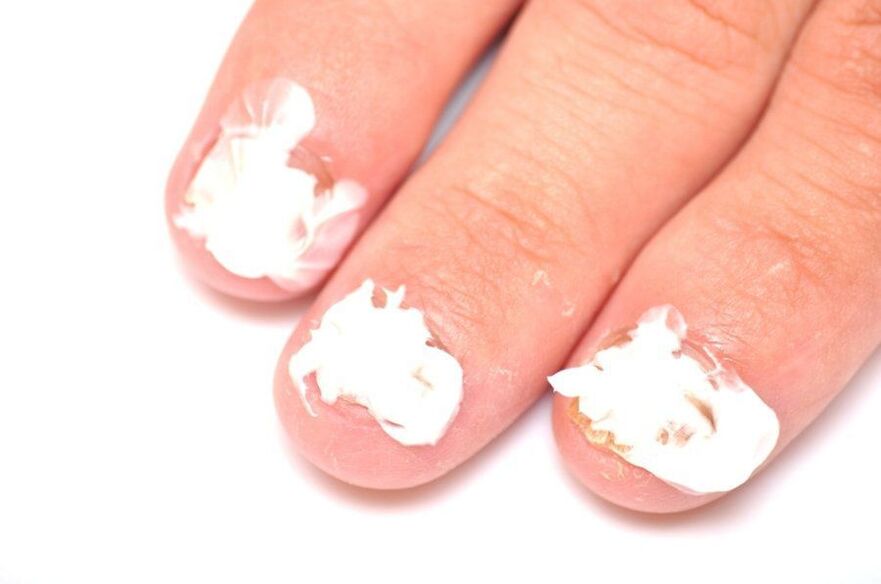
Severe fungal diseases are treated with fungicides and antifungal ointments. The second type is used after washing and drying the feet.
Folk remedies are recommended to be used only at the initial stages of the disease, as well as to relieve itching. They must be used with extreme caution as some rely on skin cauterization and can cause burns.
As for traditional medicine, patients use it at their own risk. Be especially careful when using formulations containing vinegar, celandine or manganese as they can cause skin burns.
In parallel with medicinal treatment, you can take baths with oak bark, chamomile or sage. Soda baths effectively relieve itching.
Precautions
Although there are effective and inexpensive treatments for foot fungus on the market, it's best not to let the problem develop. Preventing fungal infections includes:
- in daily hygiene;
- wear personal shoes (especially when going to the shower, public baths and swimming pools);
- regularly treat the inside of shoes with ammonia;
- change socks daily;
- Enhance and maintain immunity.
These are basic, simple measures that anyone can do. But if infection occurs, to prevent recurrence, it is necessary to treat foot fungus with medication for another 14 days after all symptoms of mycosis disappear completely.
Foot fungus: symptoms and treatment, pictures of foot fungus
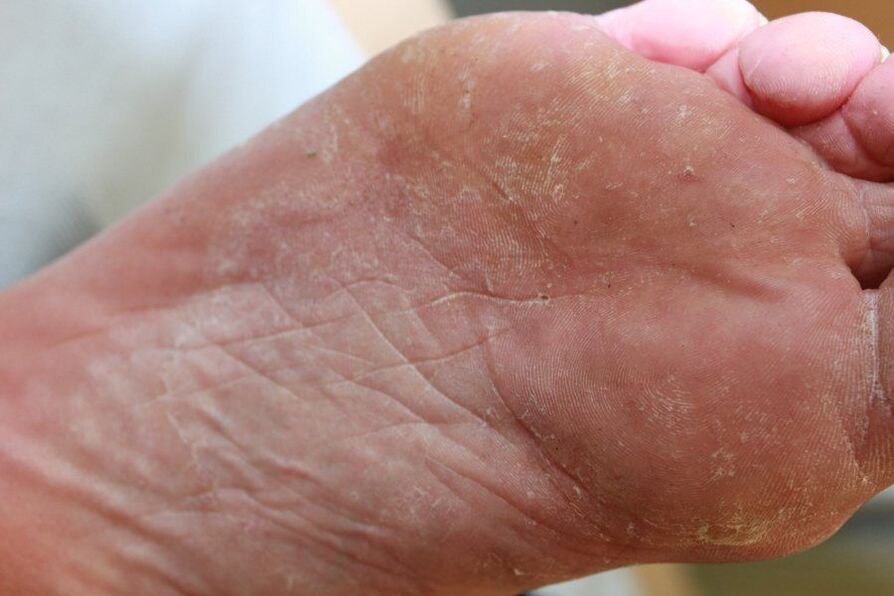
Athlete's foot is one of the most common diseases in dermatological practice. It occurs mainly in cultures where people regularly wear shoes and affects up to 70% of the adult population.
Most often, foot fungus is observed in the elderly, as well as people with significantly weakened immunity, for example, with diabetes, AIDS, circulatory disorders of the lower limbs and other diseasesbelongs to this category.
Typically, the term "fungus or mycosis of the feet" refers to lesions caused by fungal hyphae in the skin of the feet, nails, and spaces between the fingers.
Pathogens
Among the many types of fungi, the main causes of athlete's foot are:
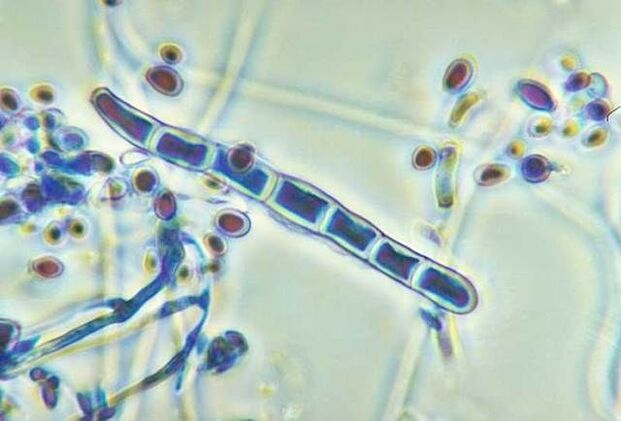
- Trichophyton rubrum,
- Trichophyton mentagrophytes,
- Epidermophyton floccosum.
Other uncommon causes of athlete's foot include:
- Trichophyton tonsurans is the causative agent of fungal disease in children in the United States,
- Candida,
- Scytalidium hyalinum,
- Scytalidium dimidiatum.
All fungal infections are adapted to parasitize the stratum corneum of the skin, producing special enzymes that decompose keratin. In addition, their membranes (cell walls) also contain manans - special substances that suppress local immunity and contribute to the development of chronic inflammation.
Path of infection and pathogenic factors
It is believed that some types of foot fungus are able to maintain their viability in patches of peeling skin for up to a year. To get a fungal infection, it is enough that such patches of skin have pathogens attached to the legs, which then fall into suitable conditions for reproduction: humidity and temperature.
The most common fungal foot infections occur:
- In public places: bathrooms, beach beds, swimming pools, saunas, even just the sand.
- In the family: sharing shoes at home, lack of separate foot towels, poor hygiene.
- Habit: exchanging shoes, socks, wearing other people's shoes (for example, wearing the host's slippers when visiting).
Factors that contribute to infection:
- Reduced local protective force due to circulatory disorders (eg, vasculitis, atherosclerosis of the lower extremities), certain chronic diseases (HIV, other immunodeficiency conditions, diabetes, etc. ).
- Prolonged foot sweating in athletes during prolonged training, in summer when wearing closed or poorly ventilated shoes.
- Cracks and cracks in the skin of the feet.
In general, men are more susceptible to the disease than women; with age, the frequency of fungal infections of the feet increases. Risk groups for fungal infections of the feet are:
- miner,
- military,
- bathroom attendant,
- regulations of baths and saunas,
- athlete.
Types of diseases
According to the location of pathological concentration of the skin on the feet affected by fungus:
- Interdigital fungal disease (dermatophytosis). It is usually observed in a chronic (squamous) or acute (intermittent) form.
- Fungal diseases of plants. Most often, it manifests itself as peeling and keratinization of the skin of the feet.
- Dyshidrotic dermatosis. Bubbles and blisters form on the skin of the feet, often reminiscent of atopic dermatitis.
- Deep fungal disease. In this case, not only the surface layer, but also the deep layer of the skin is affected.
- Nail fungus. Toenail fungal infection.
Depending on the type of pathogen, the main fungal diseases of the feet are:
- Athlete's disease is caused by Trichophyton mcntagrophytes.
- Rubrophytosis is caused by Trichophyton rubrum.
Rubrophytosis in the feet: types and main symptoms
Rubrophytosis is the most common foot fungus. Occurs in almost 70-90% of cases.
Symptom

The classic form of rubrophytosis is characterized by moderate redness and thickening of the skin (lichenification). The affected skin is shiny, has a prominent pattern, and has a dry surface with powder-like scales accumulating in the grooves and folds.
Usually the disease begins in the third or fourth fold, which is the tightest fold. The fungus then spreads to other spaces between the toes, the soles of the feet, and the back of the foot.
The following forms are characteristic of rubrophytia:
Frequent:
- scaly form (main symptom is peeling skin),
- keratinized form - presence of "corns", thickening.
- interspersed (opreloid),
- Dyhidrotic (with the formation of blisters),
- mixed form (diaper rash, blisters).
By foot
Eradicated squamous rubrophytia has the least pronounced symptoms and progresses almost unnoticed by the patient. Its main symptoms:
- Interdigital spaces: peeling, flour-like scales, small superficial cracks.
- There are practically no complaints or slight itching that may bother you.
In this form, rubrophytosis can persist for quite a long time. However, a gradual progression of the disease is observed, leading to the appearance of hyperkeratosis and mixed forms. Gradually there are:

- increased dryness of foot skin,
- roughness of the skin,
- the appearance of rough calluses on the soles and sides of the feet,
- Deep and painful cracks form in the heel area.
With rubrophytosis of the feet, there are 3 main types of skin peeling:
- Flour.The natural folds and grooves of the skin appear to be dusted with flour.
- ring shape. Red spots with sloughed epithelial edges.
- Large plate. In this case, the skin peels off in large patches.
In the inter-digital space
When feet sweat a lot, wear poorly ventilated shoes, or are improperly treated, the spaces between the toes periodically begin to get wet. The skin becomes swollen, eroded, and has deep cracks. The main complaints of patients at this stage are itching, pain, and burning.
Without timely and effective treatment, this process will gradually get worse, manifested by increasing pain and itching, which intensifies with movement. Large blisters appear on the skin of the interdigital spaces and lateral surfaces of the fingers, which later turn into ulcers, surrounded by a white epidermal border.
On the nails
Nail plates of toes with rubrophytosis:
- thicken,
- fall,
- yellow-gray or with a brown tint,
- The milky white spots then spread to the entire nail.
Sometimes they separate from the nail bed, thicken and look like a bird's claw or an ingrown nail, causing additional discomfort for the patient.
Complications of rubrophytosis
As a rule, rubrophytia spreads to other parts of the body: hands, smooth skin, vellus hair. Pathogens enter new skin areas through lymphocytes, as well as through contact (for example, transmitted by hands when washing feet).
- Hands - damage to the palms and nails.
- Smooth skin - lesions on the face, inguino-thigh folds, buttocks, legs.
In this case, mycosis manifests itself as round red or pink spots that tend to merge and grow on the periphery. Their surface is covered with scales, and along the edges there is an inflammatory ridge with small bubbles and crusts.
If rubrophytia spreads to large folds, itching will occur.
Athlete's foot: types and symptoms
Athlete's foot occurs less frequently than rubrophytosis and has similar forms of the disease:
- Deleted.
- Horns.
- Diaper rash.
- With the formation of bubbles.
- Athlete's nails.
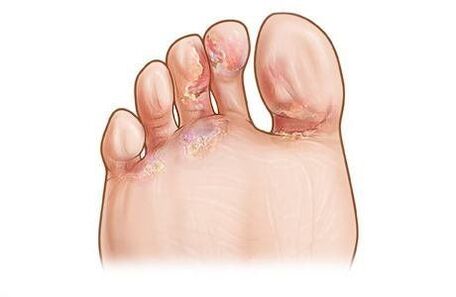
Next, red-green patches of thickened skin appear on the sides and soles of the feet. In the center of the rash there are layers of scales, the boundaries of the lesions are clear. In the spaces between the fingers, the cuticles are white.
With athlete's foot, patients feel uncomfortable because of itching, increased dryness and pain in the skin.
The opreloid (alternating) form of epidermoid disease is characterized by redness, swelling, and roughness of the interdigital folds. Cracks often form and are painful.
When the pathogen affects the arch of the foot, a form of eczema can often be observed with the formation of blisters, which after opening look like wet ulcers of pink or red color.
Athlete's foot most commonly occurs in the big toe (I) and little toe (V). In the thickness of the nail, near the free edge, yellow spots and stripes form, they gradually increase and occupy the entire nail. Next, the nail begins to crumble, sometimes peeling off the nail bed.
Podvysotskaya acute epidermoid disease
The main symptoms of this form of foot fungus:
- swelling of feet, fingers,
- abundance of vesicles,
- weeping and erosion,
- abrasion of the interdigital folds,
- enlarged inguinal lymph nodes,
- increased body temperature,
- headache,
- difficulty walking due to pain,
- general weakness.
Toe nail fungus: symptoms and types
In addition to the agents that cause rubrophytosis and epidermophytosis, onychomycosis can be caused by yeasts of the genus Candida, as well as some other types of fungi.
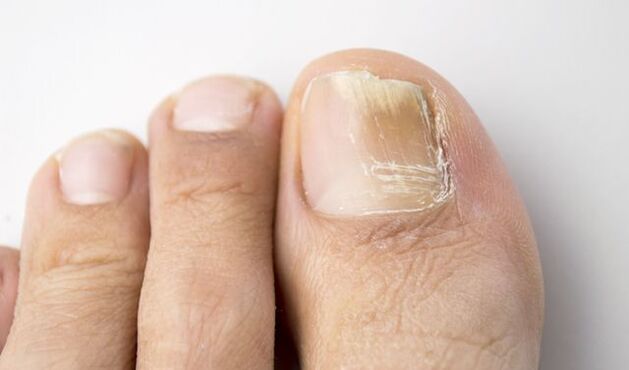
The most typical symptoms of onychomycosis, starting closer to the edge of the nail:
- discoloration, loss of natural shine,
- nail plate thickening,
- the appearance of subungual hyperkeratosis,
- The nail is destroyed and detached from the nail bed.
With nail fungus, there are 2 main types of nail damage:
- Normal: white and yellowish stripes are visible in the thickness of the nail.
- Atrophy: thinning, destruction of the nail plate, detachment.
Diagnosis of fungal foot infections
The specialist in treating fungal infections of the feet is a dermatologist, and if necessary, other specialists can be treated.
After talking with the patient, clarifying the complaints and features of the appearance and course of the disease, the doctor will examine the affected surface and prescribe some type of additional examination, for example:
- Microscopic examination with additional treatment of the material with potassium hydroxide.
- Check out Wood's lights.
- Inoculate suspicious biological material on a special medium for fungal growth, as well as on a medium intended for bacteria.
Treatment
Treatment of any fungal infection of the feet must be prescribed by a doctor to achieve complete cure.
In general, the treatment of athlete's foot is based on the following therapeutic principles:
- Fights infectious agents. In the early stages of the disease, topical medications are often prescribed - antifungal ointments, creams, lotions. In severe cases, use systemic antifungal medications.
- Increase immunity and improve local blood circulation, treat underlying diseases.
- Desensitization therapy. Since athlete's foot is often accompanied by an allergic reaction, anti-allergy medications will be prescribed accordingly to help improve the patient's condition.
Treatment at home
- To effectively treat athlete's foot, it is important to remember that fungi grow in moist environments. By eliminating moisture, fungus will not grow and the chances of cure will increase.
- Protect your family members from fungal diseases. You should explain to them that from now on you cannot walk barefoot in the apartment, especially in the bathroom or shower. After bathing, it is necessary to treat the bathtub, tray and floor with a disinfectant.
- Wash your feet every day with soap, use a napkin to collect all the fallen pieces of skin so that nothing gets under the nails.
- After washing your feet, remember to dry the space between your toes with toilet paper or a hair dryer, then apply antifungal medication as prescribed by your doctor. Treatment must be continued for several months even if the manifestations of mycosis disappear completely.
- Use powder when wearing shoes.
- Wear white cotton socks (clean daily). Used socks should be boiled or soaked in disinfectant for 10 minutes. Shoes should be disinfected with antifungal spray.
Preventing athlete's foot
Timely treatment of diseases that can reduce the body's defenses or impair blood circulation.
Conclusion
Athlete's foot is one of the most common fungal skin infections. In most cases, compliance with simple rules of prevention will help avoid diseases, and timely treatment will begin to completely eliminate fungal diseases.



























